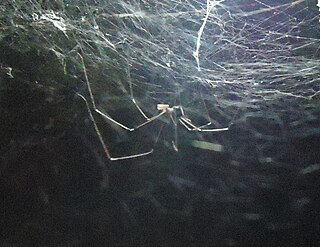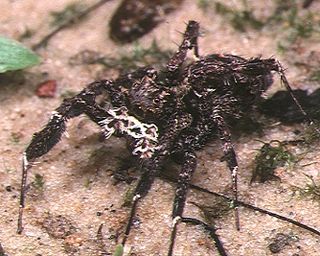
The Pholcidae are a family of araneomorph spiders. The family contains over 1,800 pholcids, including those commonly known as the marbled cellar spider , daddy long-legs spider, granddaddy long-legs spider, carpenter spider, daddy long-legger, vibrating spider, gyrating spider, long daddy, and skull spider. The family, first described by Carl Ludwig Koch in 1850, is divided into 94 genera.

Poecilotheria is a genus of Asian tarantulas that was first described by Eugène Louis Simon in 1885. They are arboreal tarantulas, commonly known as ornamental tarantulas, known for their vivid color patterns, fast movement, and potent venom compared to other tarantulas. As of 2019 all species are protected under CITES.

Pholcus phalangioides, commonly known as daddy long-legs spider or long-bodied cellar spider, is a spider of the family Pholcidae. It is also known as the skull spider due its cephalothorax resembling a human skull. This is the only spider species described by the Swiss entomologist Johann Kaspar Füssli, who first recorded it in 1775. Its common name of "daddy long-legs" should not be confused with a different arachnid species with the same common name, the harvestman (Opiliones).

Crossopriza lyoni is a widespread species of cellar spiders that prefer to live in or around human structures. They are commonly known as tailed cellar spiders, tailed daddy longlegs spiders, and sometimes box spiders. They all possess extremely long fragile legs that can reach up to 6 cm (2.4 in) long and a body length of that ranges from 2.5 to 7 mm. Their abdomens are distinctly squarish when viewed from the side and their carapace is more or less circular when viewed from above. They also possess two kinds of sound-producing organs and have six eyes.

Portia fimbriata, sometimes called the fringed jumping spider, is a jumping spider found in Australia and Southeast Asia. Adult females have bodies 6.8 to 10.5 millimetres long, while those of adult males are 5.2 to 6.5 millimetres long. Both sexes have a generally dark brown carapace, reddish brown chelicerae ("fangs"), a brown underside, dark brown palps with white hairs, and dark brown abdomens with white spots on the upper side. Both sexes have fine, faint markings and soft fringes of hair, and the legs are spindly and fringed. However, specimens from New Guinea and Indonesia have orange-brown carapaces and yellowish abdomens. In all species of the genus Portia, the abdomen distends when the spider is well fed or producing eggs.

Holocnemus pluchei, commonly known as the marbled cellar spider, is a species of Pholcidae, a family commonly referred to as "cellar spiders" or "daddy long-legs". This species is distributed across the North Pacific region of the United States, as well as in parts of North Africa, Europe, and the Mediterranean. It is considered a common household spider and builds its nest in attics, basements, and eaves of houses. Although some members of the species live in solitary webs, the majority join already existing webs and migrate to new webs multiple times throughout the course of their lives. A unique feature of H. pluchei is that while in many species of spiders, stridulation commonly occurs by males during sexual encounters, in H. pluchei, females also possess stridulatory organs, and both sexes engage in stridulation.

Panjange is a genus of leaf-dwelling spiders in the family Pholcidae, widely distributed in the islands of Southeast Asia from Borneo and the Philippines to northern Australia. Panjange spiders exhibit some of the most extraordinary morphology among Pholcidae. Males of most species have eye stalks, sometimes with long pointed processes; males of some species have unusually elongated pedipalps, which in spiders function as copulatory organs; and females of some species have external portions of their genitalia strongly folded and extensible. The biological significance of these sexual modifications remain unclear.
Oxyopes ceylonicus, is a species of spider of the genus Oxyopes. It is endemic to Sri Lanka.
Belisana ratnapura is a species of spider of the genus Belisana. It is endemic to Sri Lanka.
The name Sihala is used in following articles.
Sihala is a genus of cellar spiders in the family Pholcidae, containing two species. The two species were once classified in the genus Pholcus, but were moved due to the absence of the characteristic sclerites shown in the bulb, and the unusually small and simple procursus.
Pholcus fragillimus, is a species of spider of the genus Pholcus. It is distributed from Sri Lanka, India to Japan. The type material of Pholcus fragillimus has probably been destroyed in Stuttgart during the Second World War, and only one female is available now in museums.
Tissahamia ethagala is a species of spider in the family Pholcidae. It is endemic to Sri Lanka.
Tissahamia maturata is a species of spider in the family Pholcidae. It is endemic to Sri Lanka.
Wanniyala agrabopath, is a species of spider of the genus Wanniyala. It is endemic to Sri Lanka. The species was described with a male found from Agrabopath Forest, Agrapatana, hence the specific name.
Wanniyala hakgala is a species of spider of the genus Wanniyala. It is endemic to Sri Lanka. The species was described with a male found from Hakgala area, hence the specific name.
Wanniyala is a genus of cellar spiders native to Sri Lanka, first described by Huber & Benjamin in 2005. They have six eyes and four pair of legs and grow up to 2 mm in length. The abdomen is globular and males have a distinctive distal hinged sclerite on the procursus of genitalia. The name is derived from the Sri Lankans native to the island that the first spiders were found on- the Vedda people- and their surname Wanniyala-Aetto.






